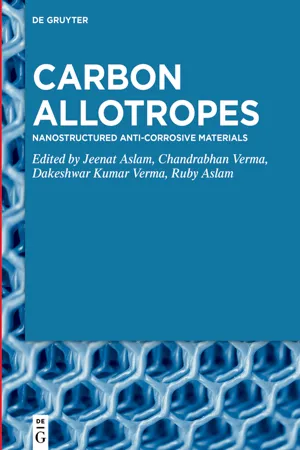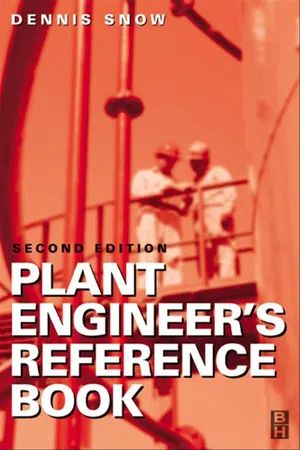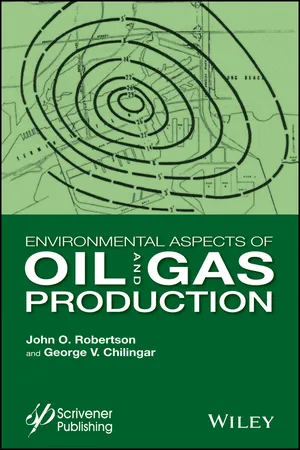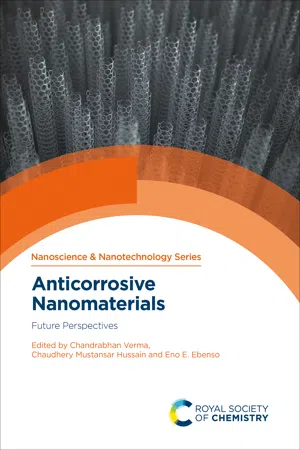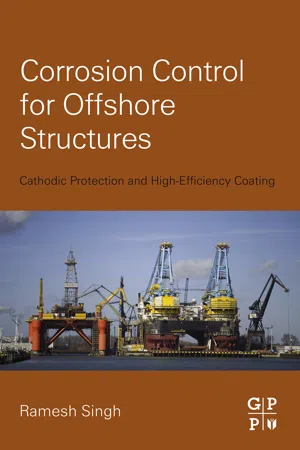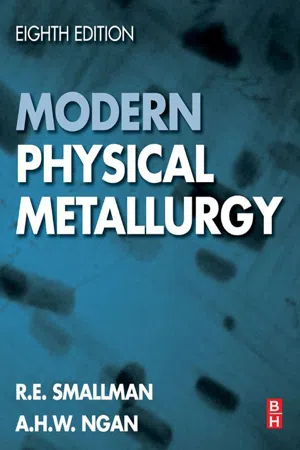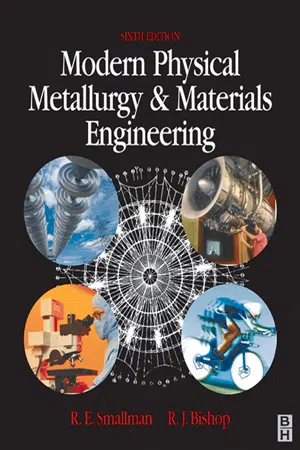Technology & Engineering
Oxidation and Corrosion
Oxidation is a chemical reaction in which a substance loses electrons, leading to the formation of oxides. Corrosion, on the other hand, is the deterioration of a material as a result of chemical or electrochemical reactions with its environment. Both processes can cause damage to metals and other materials, leading to structural weakening and potential failure.
Written by Perlego with AI-assistance
Related key terms
Related key terms
1 of 4
Related key terms
1 of 3
10 Key excerpts on "Oxidation and Corrosion"
- eBook - ePub
Physical Electrochemistry
Fundamentals, Techniques, and Applications
- Noam Eliaz, Eliezer Gileadi(Authors)
- 2018(Publication Date)
- Wiley-VCH(Publisher)
17 Corrosion 17.1 The Definition of Corrosion Corrosion, in its broad definition, is the deterioration of a material due to a reaction with its environment. This definition is so broad that phenomena such as hot corrosion and other high‐temperature oxidation processes, cracking of polymers due to sunlight, polymers degradation in the low Earth orbit (LEO) environment due to exposure to atomic oxygen (AO), environmental stress cracking (ESC), and microbiological corrosion (MIC) of polymers, glass disease, attack of silicon dioxide by hydrofluoric acid, corrosion of composites, attack of a solid metal by another molten metal (liquid metal embrittlement), etc. can all be regarded as types of corrosion. However, here we shall limit ourselves to corrosion of metals and alloys in aqueous solutions, which is normally an electrochemical process. Corrosion is a common phenomenon, observed all around us. It is found in pipes, automobiles, oilfield equipment, nuclear reactors, metallic implants, etc. Wherever there is a metal there is bound to be, sooner or later, corrosion. This is hardly surprising, since all metals, except gold, are thermodynamically unstable with respect to their oxides in air and in water. This is manifested by the observation that metals are not found in nature in their “native” or metallic form, but rather in the form of some compound, an oxide, a sulfide, a silicate, and so on. 1 The history of humankind is closely linked with the technology of reducing ores to the corresponding metals or alloys. This requires the input of energy, and the resulting product is unstable thermodynamically. Corrosion can be regarded as the natural tendency of metals to revert to a more stable state as a chemical compound of one kind or another, depending on the environment - eBook - ePub
Carbon Allotropes
Nanostructured Anti-Corrosive Materials
- Jeenat Aslam, Chandrabhan Verma, Dakeshwar Kumar Verma, Ruby Aslam, Jeenat Aslam, Chandrabhan Verma, Dakeshwar Kumar Verma, Ruby Aslam(Authors)
- 2022(Publication Date)
- De Gruyter(Publisher)
In this chapter, it has been focused to discuss the basics of corrosion, its adverse effects, and the proper implementation of the methods by which corrosion can be minimized. 3.2 Basic of corrosion Corrosion is mainly defined as the environmental degradation of materials, and it is a complex process that entirely depends on the environment where the material is exposed. Apart from the environment, corrosion also depends on the composition of materials, crystal structure of the metals, and in which circumstances metals are used. Corrosion is mainly controlled by the kinetic and thermodynamic factors. In order to control or minimize the rate of corrosion, proper understanding of kinetic and thermodynamic fundamentals of corrosion is important. The corrosion process can be explained by chemical or electrochemical reactions where the metal dissolves away from the anodic sites (oxidation), and the corresponding reduction reaction occurs at the cathode in the presence of an electrolyte [ 9 ]. Dissolution of metal (M), which is an anodic reaction, is represented by the half-cell reaction: (3.1) M → M n + + n e − The electrons liberated by the anodic reaction are consumed by the cathodic reaction to precede the corrosion phenomenon. In aqueous corrosion, two predominating cathodic reactions are oxygen reduction and hydrogen evolution. The half-cell reactions for the cathodic reactions are represented as. follows: (3.2) O 2 + 4 e − + 4 H + → 2 H 2 O i n a c i d i c s o l u t i o n (3.3) O 2 + 4 e − + 2 H 2 O → 4 O H − i n b a s i c s o l u t i o n (3.4) 2 H + + 2 e − → H 2 i n a c i d[--=PLGO-SEPARATO. R=--]i c s o l u t i o n (3.5) 2 H 2 O + 2 e − → H 2 + 2 O H − i n b a s i c s o l u t i o n Oxygen reduction can only occur in the aerated solution and hydrogen evolution can occur in both deaerated and aerated solutions. In the basic solutions, the overall corrosion process with oxygen reduction in the cathodic sites can be represented as - eBook - ePub
- DENNIS A SNOW(Author)
- 2001(Publication Date)
- Butterworth-Heinemann(Publisher)
33Corrosion
Michael J Schofield, BSc, MSc, PhD, MIM, CEng, Independent ConsultantContentsCorrosion basicsDefinitions of corrosion Electrochemical corrosion Cracking mechanisms Non-electrochemical corrosionThe implications of corrosionEconomics Safety Contamination of productMaterials selectionSources of information Aqueous systems Non-aqueous processes High-temperature environments Influence of process variables on material selection Influence of external environmentDesign and corrosionShape Stress Fabrication techniques Design for inspectionUses and limitations of constructional materialsSteels and cast irons Stainless steels Nickel alloys Copper alloys Miscellaneous metallic materials Linings and coatingsSpecifying materialsCompositional aspects Mechanical properties CertificationCorrosion-control techniquesPainting Cathodic protection Anodic protection Corrosion inhibitorsCorrosion monitoringPhysical examination Exposure coupons and electrical resistance probes Electrochemical corrosion monitoring Thin-layer activation33.1 Corrosion basics
33.1.1 Definitions of corrosionCorrosion is generally taken to be the wastage of a metal by the action of corrosive agents. However, a wider definition is the degradation of a material through contact with its environment. Thus corrosion can include non-metallic materials such as concrete and plastics and mechanisms such as cracking in addition to wastage (i.e. loss of material). This chapter is primarily concerned with metallic corrosion, through a variety of mechanisms.In essence, the corrosion of metals is an electron transfer reaction. An uncharged metal atom loses one or more electrons and becomes a charged metal ion:In an ionizing solvent the metal ion initially goes into solution but may then undergo a secondary reaction, combining with other ions present in the environment to form an insoluble molecular species such as rust or aluminium oxide. In high-temperature oxidation the metal ion becomes part of the lattice of the oxide formed. - eBook - ePub
- J. O. Robertson, G. V. Chilingar(Authors)
- 2017(Publication Date)
- Wiley-Scrivener(Publisher)
Corrosion in various forms causes many drillpipe failures while drilling wells, adding significantly to drilling costs of wells. Corrosion can occur: (1) during drilling of deep wells, (2) using higher-strength steels to drill these wells, (3) in the presence of higher stresses, (4) using lower-pH drilling fluids, etc. In all these cases, there is an increased susceptibility of metals to failure due to corrosion.Corrosion is often not only a major cause of damage to metals in wells but also in production facilities and pipelines. Corrosion damage results in costly maintenance of these facilities (repairs and replacements) in addition to the loss of production. It should also always be remembered that there are additional environmental costs due to hydrocarbon contamination.To better understand corrosion and its costs, one must first understand what corrosion is and what causes it.6.2 Definitions
6.2.1 Corrosion
In 1946, the American Electrochemical Society defined corrosion as the “destruction of a metal by chemical or electrochemical reaction with its environment.” The destruction of metals by corrosion can occur by: (a) direct chemical attack at elevated temperatures in a dry environment, and (b) by electrochemical processes at lower temperatures in a water-wet or moist environment. Corrosion occurs because metals tend to revert (oxidize) to more stable forms in which they were initially found in nature, i.e., oxides, sulfates, sulfides, or carbonates.Inasmuch as the corrosion mechanism (oxidation) is the same for all metals and alloys, differing only in degree, it is useful to examine the mechanism of corrosion for iron.In the case of electrochemical reaction, the magnitude of electrochemical potential for a particular metal determines the tendency of the reaction to proceed, whereas the resistance offered by the corrosion products, to the continued progress of the reaction, determines the rate of corrosion.6.2.2 Electrochemistry
Chemical reaction is caused by an external voltage (voltage caused by a chemical reaction) as in an electrochemical cell. In general, electrochemistry deals with oxidation and reduction reactions. The following electrical terms are widely used in electrochemistry and corrosion science: - eBook - ePub
- Sir Alan Cottrell(Author)
- 2019(Publication Date)
- CRC Press(Publisher)
Chapter 23Oxidation and Corrosion
23.1 Introduction
The free energy values in Chapter 7 showed us that most metallic elements exist naturally in the atmosphere in an oxidized condition. The main problem of extraction metallurgy is to convert them to the metallic state against this natural tendency. In this chapter we shall now consider the processes by which such metals revert to an oxidized state, i.e. processes of oxidation and corrosion. Although oxidation in the sense of removing electrons to convert atoms into positive ions occurs in most forms of metallic corrosion, it is usual to limit the term oxidation to the chemical reaction of a dry metal surface with an oxidizing gas, sometimes also called dry corrosion or tarnishing, and to refer separately to wet corrosion or aqueous corrosion when the chemical attack takes place through the medium of water.Both types of corrosion are of course extremely important. Oxidation limits the use of metals in high temperature power plant and is responsible for the mill scale which gives hot-rolled steel such a rough surface. Wet corrosion, particularly the rusting of steel in moist air and water, is one of the major technological problems of modern society. It costs the United Kingdom well over £1000 million a year in metal losses and preventive measures. There are a few practical benefits from Oxidation and Corrosion: the green patina on copper roofs pleases the eye; the lead-acid battery depends on corrosion reactions; chemical etching, electrochemical machining and oxygen flame cutting are useful for shaping metals; and anodic oxidation is the basis of electrolytic polishing; but these are insignificant in comparison with the harmful aspects of corrosion.23.2 Oxidation
Suppose that the surface of a reactive metal is exposed to an oxidizing gas such as dry air or oxygen, or hot dry steam. At high temperatures some metals form molten or volatile oxides, e.g. V2 O5 on vanadium and MoO3 - eBook - ePub
Anticorrosive Nanomaterials
Future Perspectives
- Chandrabhan Verma, Chaudhery Mustansar Hussain, Eno Ebenso, Chandrabhan Verma, Chaudhery Mustansar Hussain, Eno Ebenso(Authors)
- 2022(Publication Date)
- Royal Society of Chemistry(Publisher)
Chapter 3 An Overview of CorrosionMARZIYA RIZVIa , HUSNU GERENGI,b , PREETI GUPTAa AND OMAR DAGDAG,ca Department of Chemistry, Babasaheb Bhimrao Ambedkar University, Lucknow 226003,b Corrosion Research Laboratory, Department of Mechanical Engineering, Duzce University, Duzce, Turkey;c Laboratory of Industrial Technologies and Services (LITS), Department of Process Engineering, Height School of Technology, Sidi Mohammed Ben Abdallah University, P.O. Box 2427, 30000, Fez, Morocco Email: [email protected]3.1 Introduction
The capability of an electrochemical reaction to decompose large entities to their elements or to new compounds altogether can be preservative as well as destructive.1 Corrosion is resultant of electrochemical reactions between metals and substances like inhibitors in a harsh environment. Corrosion is a degradation resultant of chemical reactions. The chemical attack of a gas or liquid on a metal is accelerated by high temperatures, acids and often salts. Generally, products of corrosion such as rust, patina, etc. , remain on the metal and save it. When this product debris is removed the surface is exposed again and the degradation follows continuously. Few materials are naturally resistant to corrosion; the materials which do not have a natural tendency to prevent corrosion undergo processes such as painting, galvanizing, coating, anodizing, etc.Corrosion is both an expensive as well as a dangerous situation. Collapsed buildings and bridges, broken oil pipelines, leaking chemical plants and flooded bathrooms are usually caused by corrosion. Fires are caused by corroded electrical contacts, blood poisoning caused by corroded medical implants and corrosive air pollution has caused damage to some archaeological heritage sites worldwide. Radioactive waste requires storage for tens and thousands of years, but corrosion threatens the safe disposal of such wastes too. - eBook - ePub
Corrosion Control for Offshore Structures
Cathodic Protection and High-Efficiency Coating
- Ramesh Singh(Author)
- 2014(Publication Date)
- Gulf Professional Publishing(Publisher)
In common speech as well as in the NACE definition above, the word corrosion signifies deterioration of material, an element of natural degradation is implied. There is an element of correctness with this common understanding—there is degradation and nature is taking part in that degradation.The above definition is a good description of the physical appearance of the action of corrosion. However, it does not address every aspect of the scientific explanation of corrosion. For example, it does not explain the flow of energy and thermodynamic reactions involved in the corrosion process. Although the thermodynamic reaction could be grouped with the environment aspect of the corrosion, it is, in itself, a very prominent aspect that needs independent study.The following discussion complements the discussion we have had so far and addresses additional scientific explanations to bring about a better understanding of the term corrosion, one that is suitable for engineers.Flow of Energy
Corrosion occurs in nearly all materials produced by nature or manmade materials; this includes metals and nonmetals such as certain plastics, ceramics, and concrete. In order to find the correct definition of the word corrosion, a question arises, why do metals corrode? A search for the answer leads us to the realm of thermodynamics.Thermodynamics is the science of the flow of energy. This science explains a specific corrosion process and indicates if corrosion is possible in a given metal and environment. The flow of energy in the corrosion process is in the form of electrical energy. The rate of corrosion is similarly predicted by the kinetics. We discuss these topics in more detail in later sections of this book. As we know, with the exception of a few naturally occurring metals, most engineering materials are found in the form of ores, often metal oxides found in nature. A lot of energy is spent in the extraction process of these usable metals from their ores. Hematite (Fe2 O3 ) is an ore of iron, and bauxite (Al2 O3 ·H2 O) is an ore of aluminum, there are some more complex ore like that of Nickel ore kupfer-nickel, smaltite ores are a combination of sulphur and arsenic which are roasted to form an oxide which is then reduced to the metal by hydrogen and purified by the Mond process to obtain nickel that engineers can use. Copper is found as pure metal; that is the reason copper is usually free from corrosion, but it is also extracted from various ores like Ruby ore (Cu2 O), Copper Glance (Cu2 S), or Pyrite (CuFeS2 ). It may be pointed out that copper obtained from nature and copper extracted from ores would display different potentials. As we can see, a lot of energy is put into the extraction of engineering metals. Some metals that are extracted as free metals from the earth and do not require additional energy to convert the natural form to make it usable are very low in corrosion galvanic energy. These metals are called Nobel metals. In the galvanic table, Table 2.1 - eBook - ePub
- A S Khanna(Author)
- 2016(Publication Date)
- WSPC(Publisher)
Chapter 1
Fundamentals of High Temperature Oxidation/Corrosion
A.S. KhannaDepartment of Metallurgical Engineering and Materials Science Indian Institute of Technology Mumbai 400076, IndiaMaterial degradation at high temperatures takes place due to loss in mechanical properties with increase in temperature as well as due to the chemical interaction of metal with the environment. This chemical interaction is further sub-divided into oxidation, sulfidation, and hot corrosion. While oxidation leads to the formation of oxide, which can be deleterious if the oxide is fast growing and spalls extensively, however, if the scale formed is adherent, thin and slow growing, it provides protection to the base metal or alloy. Sulfidation is a much severe degradation process and several times faster than the oxidation. In many industrial environments, it is a mixed gas environment, leading to oxidation and sulfidation simultaneously. Hot corrosion is another degradation mechanism which is even more severe than the oxidation and the sulfidation. Here, oxidation/sulfidation occurs in the presence of a molten salt on the surface of the substrate. Related issues, such as role of defect structure, active element effect and stress generation, during oxide growth process, have also been discussed. Finally, a guide to material selection for high temperature application is presented.1.Introduction
Corrosion eats away several billions of our hard earned money in replacement, repair and maintenance of several components, parts or the whole equipment, due to leakage, catastrophic accidents or due to plant shut down. One of the main reasons of corrosion of metals and alloys is the reaction with environment around it, which may be natural atmosphere, or the liquid or gaseous environment around the metallic component. Many corrosion failures occur at room temperature for which some electrolyte is necessary. However, at high temperatures, the corrosion occurs due to direct reaction of metal with its environment. For example, steel exposed to oxygen at room temperature does not cause any reaction of oxygen with metal, however if the same steel is exposed to oxygen at 600°C, the steel reacts with oxygen, forming various iron oxides on the surface. Thus, the main criteria of corrosion of a metal under the gaseous environment at high temperature is its tendency to form an oxide or other products, for which the free energy of the formation must be large negative. For example, for a reaction, - eBook - ePub
- R. E. Smallman, A.H.W. Ngan(Authors)
- 2013(Publication Date)
- Butterworth-Heinemann(Publisher)
Chapter 16Oxidation, Corrosion and Surface Engineering
This chapter discusses Oxidation and Corrosion. The thermodynamics and kinetics of oxidation are first reviewed. The various kinetic laws including parabolic, logarithmic and linear are described. Metallurgical factors affecting oxidation rates and oxidation resistance are also outlined. The discussion on corrosion begins with electrochemistry, and the electrochemical and galvanic series. Then, principles and practical methods on corrosion protection are introduced, followed by a discussion on the failure modes of corrosion. The chapter ends with a discussion on surface engineering which aims to improve the surface resistance to Oxidation and Corrosion.Keywords
Oxidation; oxidation laws; Pilling–Bedworth ratio; corrosion; electrochemical series; galvanic series; corrosion protection; corrosion failure; surface engineering16.1 Surfaces and environment
The general truth of the engineering maxim that ‘most problems are surface problems’ is immediately apparent when one considers the nature of metallic corrosion and wear, the fatigue cracking of metals and the effect of catalysts on chemical reactions. For instance, with regard to corrosion, metal surfaces commonly oxidize in air at ambient temperatures to form a very thin oxide film (tarnish). This ‘dry’ corrosion is limited, destroys little of the metallic substrate and is not normally a serious problem. However, at elevated temperatures, nearly all metals and alloys react with their environment at an appreciable rate to form a thick non-protective oxide layer (scale). Molten phases may form in the scale layer, being particularly dangerous because they allow rapid two-way diffusion of reacting species between the gas phase and the metallic substrate. ‘Wet’ or aqueous corrosion, in which electrochemical attack proceeds in the presence of water, can also destroy metallic surfaces and is responsible for a wide variety of difficult problems throughout all branches of industry. The principles and some examples of ‘dry’ and ‘wet’ corrosion will be discussed in Section 16.2 - R. E. Smallman, R J Bishop(Authors)
- 1999(Publication Date)
- Butterworth-Heinemann(Publisher)
Chapter 12Corrosion and surface engineering
12.1 The engineering importance of surfaces
The general truth of the engineering maxim that ‘most problems are surface problems’ is immediately apparent when one considers the nature of metallic corrosion and wear, the fatigue-cracking of metals and the effect of catalysts on chemical reactions. For instance, with regard to corrosion, metal surfaces commonly oxidize in air at ambient temperatures to form a very thin oxide film (tarnish). This ‘dry’ corrosion is limited, destroys little of the metallic substrate and is not normally a serious problem. However, at elevated temperatures, nearly all metals and alloys react with their environment at an appreciable rate to form a thick non-protective oxide layer (scale). Molten phases may form in the scale layer, being particularly dangerous because they allow rapid two-way diffusion of reacting species between the gas phase and the metallic substrate. ‘Wet’ or aqueous corrosion, in which electrochemical attack proceeds in the presence of water, can also destroy metallic surfaces and is responsible for a wide variety of difficult problems throughout all branches of industry. The principles and some examples of ‘dry’ and ‘wet’ corrosion will be discussed in Section 12.2 .Conventionally, the surface properties of steels are improved by machining to produce a smooth surface texture (superfinishing), mechanically working (shot-peening), introducing small atoms of carbon and/or nitrogen by thermochemical means (carburizing, nitriding, carbo-nitriding), applying protective coatings (galvanizing, electroplating), chemically converting (anodizing), etc. Many of these traditional methods employ a liquid phase (melt, electrolyte). In contrast, many of the latest generation of advanced methods for either coating or modifying material surfaces use vapours or high-energy beams of atoms/ions as the active media. Their successful application on a commercial scale has revealed the merits of developing a new philosophy of surface design and engineering. In Section 12.3
Index pages curate the most relevant extracts from our library of academic textbooks. They’ve been created using an in-house natural language model (NLM), each adding context and meaning to key research topics.
Explore more topic indexes
Explore more topic indexes
1 of 6
Explore more topic indexes
1 of 4

